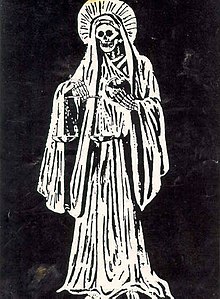This article needs additional citations for verification. (October 2024) |

Skull art is found in various cultures of the world.
Indigenous Mexican art celebrates the skeleton and uses it as a regular motif. The use of skulls and skeletons in art originated before the Conquest: The Aztecs excelled in stone sculptures and created striking carvings of their Gods.[1] Coatlicue, the Goddess of earth and death, was portrayed with a necklace of human hearts, hands and a skull pendant. She was imbued with the drama and grandeur necessary to dazzle the subject people and to convey the image of an implacable state. The worship of death involved worship of life, while the skull – symbol of death – was a promise to resurrection. The Aztecs carved skulls in monoliths of lava, and made masks of obsidian and jade. Furthermore, the skull motif was used in decoration. They were molded on pots, traced on scrolls, woven into garments, and formalized into hieroglyphs. Hindu temples and depiction of some Hindu deities have displayed skull art.
- ^ Jones, Jonathan (2 May 2008). "Skull art is not a new idea". The Guardian.